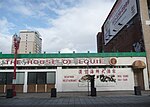Drag-a-thon
Drag-a-thon was a drag show held during July 10–12, 2023, at the drag venue Darcelle XV Showplace in Portland, Oregon. The event was a successful attempt at setting a Guinness World Record for the longest drag stage show. Drag-a-thon was conceived and produced by Emma Mcilroy, co-founder of Wildfang, in response to the Tennessee Adult Entertainment Act and similar anti-drag legislation across the United States. Eden Dawn, the host venue Darcelle XV Showplace, and its longtime performer Poison Waters were also credited as co-organizers. Drag-a-thon was also a fundraiser, yielding approximately $290,000 for LGBT support service The Trevor Project. Participants included RuPaul's Drag Race contestants Eureka O'Hara, LaLa Ri, and Peppermint, as well as Fred Armisen, spouses Lance Bangs and Corin Tucker, spouses Janine Brito and Paula Pell, Carrie Brownstein, Cameron Esposito, Laura Gibson, Frankie Grande, Punkie Johnson, Meghan Klingenberg, Stacy London, Sarah Marshall, John Cameron Mitchell, Katelyn Ohashi, Busy Philipps, members of the band Portugal. The Man, and Cheryl Strayed. The sold-out show saw 2,500 tickets distributed for 160 seats, with admission also possible via stand-by. The event featured 600 songs and 700 set changes, and set a new record of 48 hours, 11 minutes, and 30 seconds. Among audience members was Multnomah County Commissioner Jessica Vega Pederson. RuPaul and Earl Blumenauer congratulated organizers and participants for their efforts.
Excerpt from the Wikipedia article Drag-a-thon (License: CC BY-SA 3.0, Authors).Drag-a-thon
Northwest Davis Street, Portland Old Town
Geographical coordinates (GPS) Address Nearby Places Show on map
Geographical coordinates (GPS)
| Latitude | Longitude |
|---|---|
| N 45.5248 ° | E -122.6733 ° |
Address
Portland Skidmore/Old Town Historic District
Northwest Davis Street
97240 Portland, Old Town
Oregon, United States
Open on Google Maps









